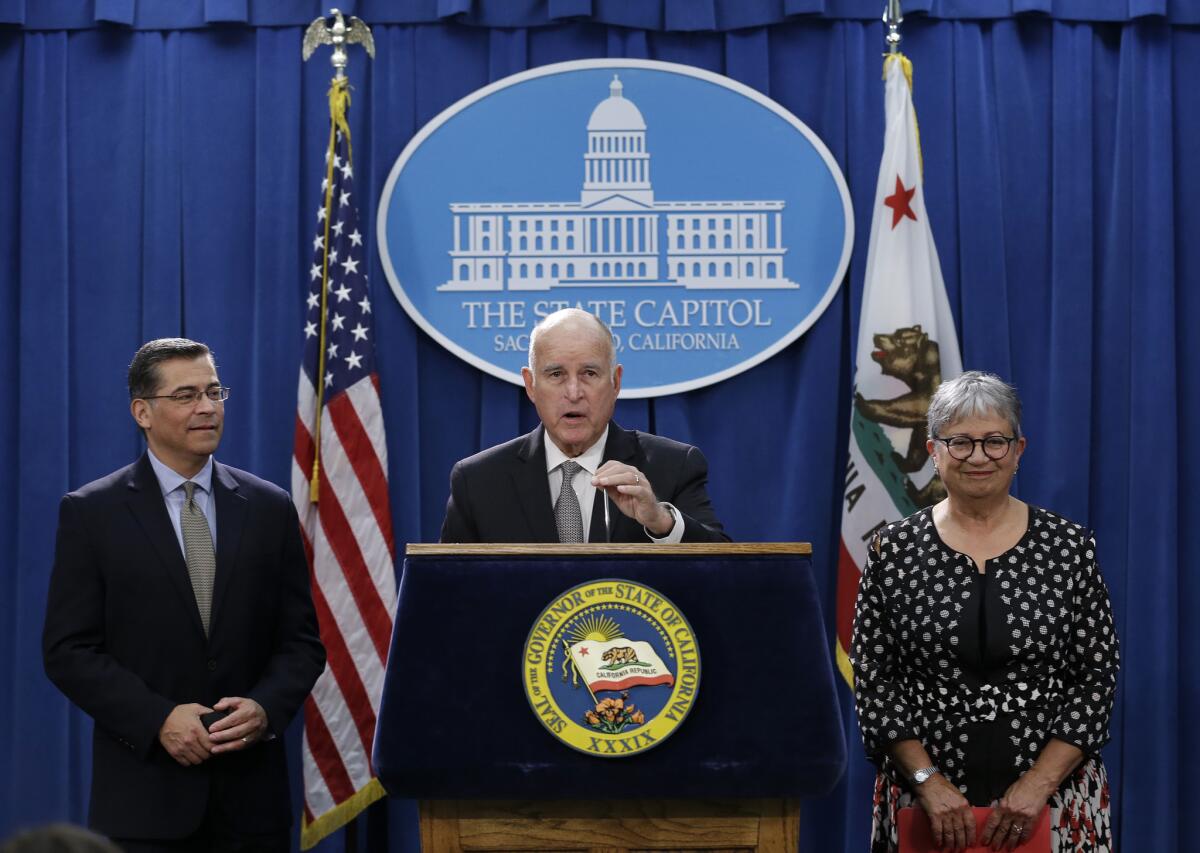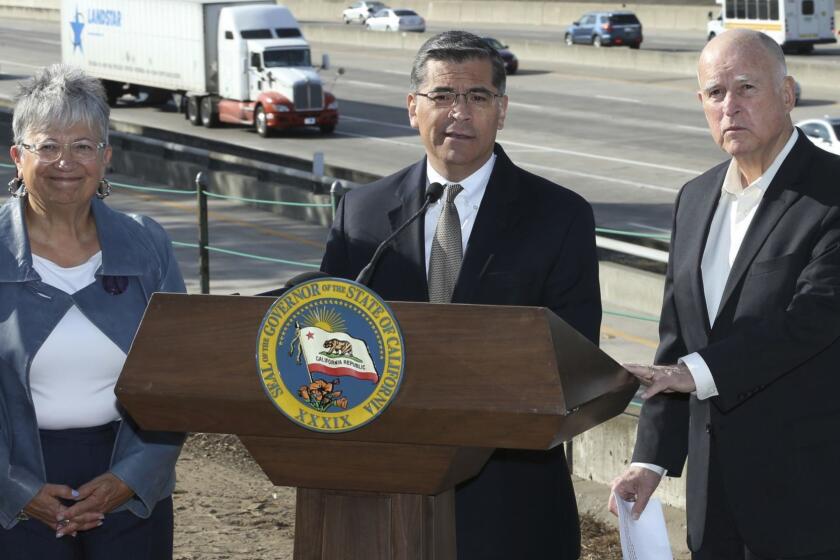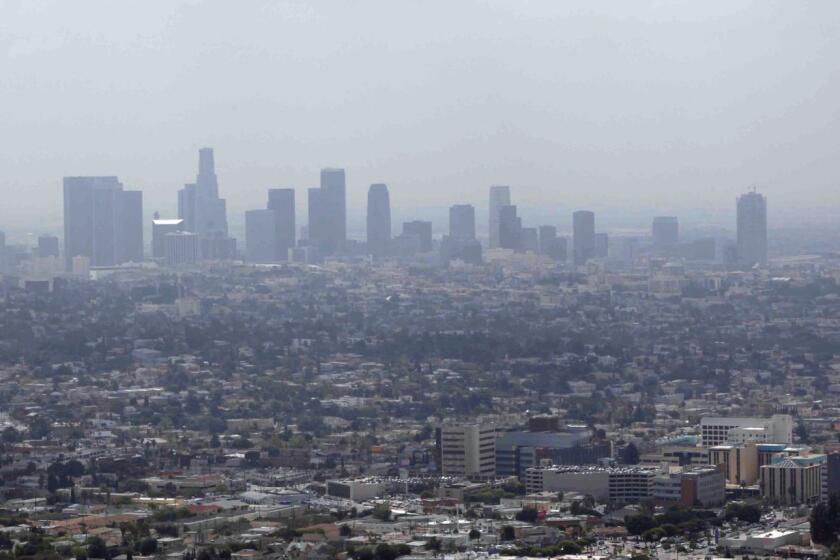With emissions deal, California takes aim at automakers’ alliance with Trump

- Share via
On Aug. 17, California finalized its agreements with five major automakers aimed at upholding its stringent vehicle emissions standards against an effort by the Trump administration to roll the rules back.
In doing so, the state delivered an unmistakable warning to the rest of the auto industry: California’s rules are likely to remain in place, and if you’ve got brains, you’ll join us.
The state carefully crafted its agreements with Ford, Honda, BMW of North America, Volkswagen Group of America and Volvo to keep them free from interference by the federal Environmental Protection Agency or anyone else in the Trump administration.
Both we and the companies consider this to be an enforceable agreement.
— Mary Nichols, chair, California Air Resources Board
Those five automakers, including Rolls-Royce (represented by BMW in the deal) and Audi (owned by Volkswagen), account for about 30% of U.S. auto sales.
“This is not a regulation, but a contract,” Mary Nichols, chairwoman of the California Air Resources Board, told me. “We’re carefully avoiding anything that would trigger going back to EPA for approval, particularly in the current context of who’s running EPA. We’re avoiding getting dragged into litigation about our authority, but both we and the companies consider this to be an enforceable agreement.”
A lot of history is packed into Nichols’ words. What’s most important is that California seems to have found a bulwark against Trump’s environmental vandalism — going its own way. The finalized deal loosens California’s emissions standards very slightly, but keeps them far ahead of the standard that Trump has called for.
This could pose a problem for the automakers that explicitly have tied their fates to Trump by filing a legal brief on the government’s behalf in a lawsuit brought by California in opposing the Trump rollback.
The major companies sticking with Trump are GM, Fiat Chrysler and Toyota, but they were joined in the so-called Coalition for Sustainable Automotive Regulation by such other manufacturers as Subaru, Hyundai, Mazda and Nissan.
Those automakers could wind up on the wrong side of the courtroom come November. If Democrat Joe Biden wins the presidential election, it’s almost certain that the Trump rollback will be consigned to oblivion.
Nichols says her agency hasn’t received any formal overtures from the holdouts about switching sides.
California’s climate deal with automakers shows the proper solution to Trump is to go around him.
“As we get closer to November and they start thinking about what might happen with a new administration, some new thoughts might dawn on them,” she said. “We’re not pursuing any new sign-ups at this point, and nobody has come in and said, ‘Hey, can I sign this deal, too.’ But they’re all looking at what the future portends” and at how the California agreement “might be a road map at how they might proceed at the national level.”
A rehash of the back story will help here. California has been a leader in clean-air regulation for decades, partly out of necessity and partly as an expression of progressive policy-making. Congress first recognized that leadership in 1970, when it granted the state the right to seek waivers from federal environmental rules that normally would have preempted state law.
Since then, California’s waiver applications have almost invariably been granted (a rejection by the George W. Bush administration in 2007 was overturned by the Obama White House in 2009). The Obama administration approved the most recent waiver in 2013.
As part of its rollback of environmental protections, the Trump administration revoked the 2013 waiver last year. California has sued to restore it, asserting that the government has no right under federal law to rescind a waiver, and that even if it did, Trump didn’t take the necessary steps to do it right by making its case with facts and documents.
Along with 22 other states, the District of Columbia, the cities of New York and Los Angeles and several environmental groups, California is also suing to block Trump’s rollback of vehicle emission standards generally. The auto industry has joined the case on the government‘s side.
Trump’s rollback was launched at the behest of big automakers. They’ve groused for years that they couldn’t conceivably meet standards for fuel efficiency and greenhouse gas emissions that were first set jointly in 2010 by the EPA and the National Highway Transportation Safety Administration, covering 2012 through 2016.
Two years later, those agencies coordinated with the California Air Resources Board to harmonize the federal and state goals and extend them through 2025.
There was a fair amount of perplexity at the California Air Resources Board on Feb. 21, when the Trump administration abruptly announced that it had decided to “discontinue discussions” with the state’s air quality regulator over the administration’s proposal to gut federal auto emissions standards.
The auto industry especially resented the California waiver, asserting that it opened the door to a patchwork of state-level regulation rather than a single national rule.
That was the goal of its intervention in the lawsuit, according to a trade group. “With our industry facing the possibility of multiple, overlapping and inconsistent standards that drive up costs and penalize consumers, we had an obligation to intervene,” John Bozzella, chief executive of what is now the Alliance for Automotive Innovation, said last year.
We’ve reported before on the transparent fakery of the argument that the conflict between state and federal rules produces costly “uncertainty” for automakers. Until Trump’s advent, the federal and California standards were in harmony, so the state standards were tantamount to a de facto national standard — California’s vehicle emission standards have been adopted by 13 other states, meaning that they already apply in about 36% of the U.S. auto market.
It was the auto industry that demanded that this harmony be broken up. As we observed in 2018, this was a bet that California would back down or be forced down, a bad wager either way.
The better bet was that the industry would be sorry that it got what it asked for, namely industry chaos. California nimbly split the industry in two. If automakers wanted certainty, they might as well have worked harder to meet the California standards.
What’s driving the industry isn’t really the “uncertainty” of multiple regulations — it‘s the desire for looser regulations.
The rules established under the Obama administration called for average vehicular fuel efficiency to rise to 54.5 miles per gallon by 2025, applicable starting in model year 2017. The state’s agreement requires the five signing companies to meet a standard of about 50 miles per gallon by 2026.
Compare that slight rollback to the Trump administration’s plan, which is to freeze the auto mileage standard at the 2020 level, only 36.9 mpg.
GM, Chrysler and Toyota are siding with the Trump administration in attacking California’s auto emissions rules.
The Trump plan was half-baked from the start and never got fully cooked. The Obama-era rules were based on detailed technical analyses. The published justification for Trump’s proposal was risibly absurd.
It asserted that loosening the regulations would reduce auto fatalities because the more stringent Obama mileage rules would prompt manufacturers to make lighter cars, which are more dangerous and prompt owners to drive more, which is more dangerous.
These findings were debunked by 11 experts at leading universities, including UC, USC, Yale and MIT. Meanwhile, American Honda broke with its auto-manufacturig cousins by asserting that Trump’s plan “invites litigation and regulatory uncertainty, ... exacerbates climate-related environmental impacts,” would slow the industry transition to an electric-vehicle future, and would be more dangerous than the Obama rules.
The sloppiness of the Trump analysis is part of the 22 states’ case against the proposed new rules. The states’ lawsuit, which is before a federal appeals court in Washington, D.C., is likely to be pending at least through late this year, but the government already has lost on motions in which it tried to expedite a ruling and to keep relevant technical documents out of court.
What’s really at issue is the industry’s position that technological challenges and the public’s thirst for gas-guzzling pickups and SUVs prevent it from meeting the efficiency standards developed by the Obama administration and California. The state thinks that’s baloney.
The Trump administration will have to go far to outdo, for sheer fatuousness and self-refutation, the excuses it trotted out Thursday for freezing government auto emissions standards and attacking California’s right to set its own rules.
“They are really saying that they can’t meet the standards without purchasing credits,” Nichols says. These are emission allowances earned by companies with products emitting low levels of greenhouse gases, such as electric cars, that can be sold to companies that market dirtier vehicles. “General Motors doesn’t want to sell fewer higher-emitting light trucks and they don’t want to spend money on credits that they would have to pass on to the consumer.”
Yes, technological change can require a costly investment, but GM and its fellow automakers know that the internal combustion engine will be at the end of the road, sooner or later. Instead of wasting time and energy trying to stave off the inevitable, they could have accepted it and geared up to meet standards that have been in place for more than seven years.
But they chose to hitch their wagon to Trump’s star, apparently forgetting that his tenure in the White House is finite and his successor’s worldview might be closer to Obama’s.
It’s surely too soon to predict who will win the presidential election in November, but the future will come inexorably closer no matter the political outcome. Ford, BMW, VW, Honda and Volvo have moved to future-proof themselves by cutting a voluntary deal with California that will last beyond the next election and the one after that.
They’re following the precept of the technology pioneer Alan Kay that “the best way to predict the future is to invent it.” GM, Fiat Chrysler, Toyota and the other Trump allies are tying themselves tight to the past, and that’s never a good bet.
More to Read
Inside the business of entertainment
The Wide Shot brings you news, analysis and insights on everything from streaming wars to production — and what it all means for the future.
You may occasionally receive promotional content from the Los Angeles Times.














